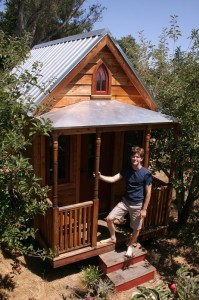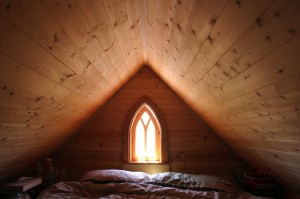A few years ago I did an interview I did with Jay Shafer, one of the leaders of the tiny house movement. This meeting was a last minute decision while I was travelling down the west coast, so I arrived at his little home on short notice and unprepared. It was only later when I did my research that I realized he’s relatively famous and has even been on Oprah. So it took some accidental gumption to show up on a whim. When I got there he was in his boxers surfing YouTube videos, having forgotten I was coming. So I guess it all came out even, and the interview was great. Here’s part of it.
Jay Shafer:

“It seems like the tiny house movement started surprisingly because I was living in my tiny house, other people were living in their tiny houses, and suddenly it was called a movement. I guess it was an evolution, but I just didn’t notice it coming. But its caught on, this idea of living with less. Probably not just because people are starting to feel a little guilty about the 18 tonnes of greenhouse gases that their Mcmansions are pumping into the atmosphere each year, but also because I think people are getting tired of vacuuming, and dusting, and all those things that go along with a big house.
It’s kind of a hard sell in America where bigger means better. At least that´s what the perception is. No matter how little nutrition there is in food, we love our giant burgers and other stuff. As long as it’s cheap and big we like it. Less square footage is actually more expensive per square foot. When you break it down square footage is the cheapest thing you can add on to a house. So in this country we love big houses because they’re relatively cheap per square foot. That said, my house is one of the most expensive houses in this area, but overall it´s still the cheapest because it’s only 100 square feet.
I think people in this country are starting to catch on finally. The housing industry has pushed the bigger house thing ever since the 70’s and 80’s, when their profits started to level off. They realized they couldn’t sell more houses, so they just started selling more house. Just bigger houses. And started pushing for codes that would prohibit smaller houses. And the banks started following suit by giving loans only for larger houses. And at this point it seems like there’s probably need for somewhat of a backlash. Until we get back to normal, or something sustainable. So it seems like people are catching on that bigger is not necessarily better, in fact it can be a lot worse.

As far as the type of design that’s used, I call it subtractive design. And just like everything else I’ve thought was really smart that I ever came up with, it turns out its already been coined, this term. It’s used in computer design, and machine design – in every kind of design except its been largely forgotten in American housing design. But it’s just a matter of paring things down to what is actually functioning in a design. So my laptop computer is small and it’s really functional, and that’s really appreciated. In machine design subtractive design’s value becomes really evident because the more parts you have, the more likely something is to break down. And in housing the same remains true it’s just that people have forgotten that the more space you have, it may be cheaper per square foot, to buy, but it’s going to be cheaper overall to buy a smaller house and besides that there’s the expense of just having to vacuum, dust, heat every room, cool every room, and of course there’s the environmental impact too. The average American house puts out 18 tonnes of greenhouse gases per year into the environment, and that’s not to mention the amount of fossil fuels and non-renewable resources that it’s consuming to do that. So it’s huge.
I wanted to build a very high quality house, something that was really nice, and by building small I was able to do exactly what I wanted with no budget. I figured how much money could I actually put into 100 square feet? I might as well just go all the way. I discovered that you actually can put a lot of money into 100 square feet. But I’m really glad I did, because I live in a house that meets my needs and I just love everything about it.
I should clarify this right now – I think larger houses are great when they’re built for many people, when space is being used well and its designed to really meet needs without exceeding needs, it usually winds up being really attractive to me. But when there’s just a lot of extra space tacked on for the sake of being spacious, I find that ugly. I think it looks pretentious actually. I wanted to live in a place that expressed my ethics as aesthetics. I wanted to express simplicity.

Voluntary simplicity is a term I wasn’t familiar with until I built my house, but I think it was exactly what I was doing. I think it’s what a lot of people are doing whether they know it or not. It’s just part of nature. Everything in nature seems to operate on voluntary simplicity it just pares itself down to its essence and functions very well that way. It seems like the human ego is the only thing that stands outside of that realm, from what I can see.”

Leave a Reply